This post is one in a series following six brewers collaborating to each make a small adjustment to a single recipe in order to improve it, then pass it along to the next brewer. We hope to learn more about the art of recipe creation as we see how other brewers approach the same recipe. The rest of the series can be found here.
Author: C. McKenzie
Brew Day
I’ve tasted each version of this stout from the beginning and although each has only had one change made to it, each change has resulted in a surprisingly different beer. Although I’ve gotten to taste each version and have been talking with each brewer during their process, I was excited to get this stout’s recipe back in my hands. Unfortunately, my brew day was delayed by a shipping disaster; Iteration 6 made it all the way across the country and into my state before it was reported as a damaged package. Needless to say, this was a giant bummer.
Eagerly anticipating the arrival of the second attempt at shipping Iteration 6 cross-country, I sat down and looked at what had been changed so far, already thinking that I was wanting to change something outside of the malt but not knowing how to approach it since I had yet to see the latest version of the recipe. Once the beer arrived and I tasted it, though, I had a pretty good idea what I wished there was more of in the recipe.
The much delayed brew day arrived, and I mashed in, overshooting my target mash temperature by one degree. My mash tun was filled to the brim, so I had no means of adjusting the temperature down (by the addition of ice or cold water) and let the slight variance ride. After an hour, I returned to collect the wort.
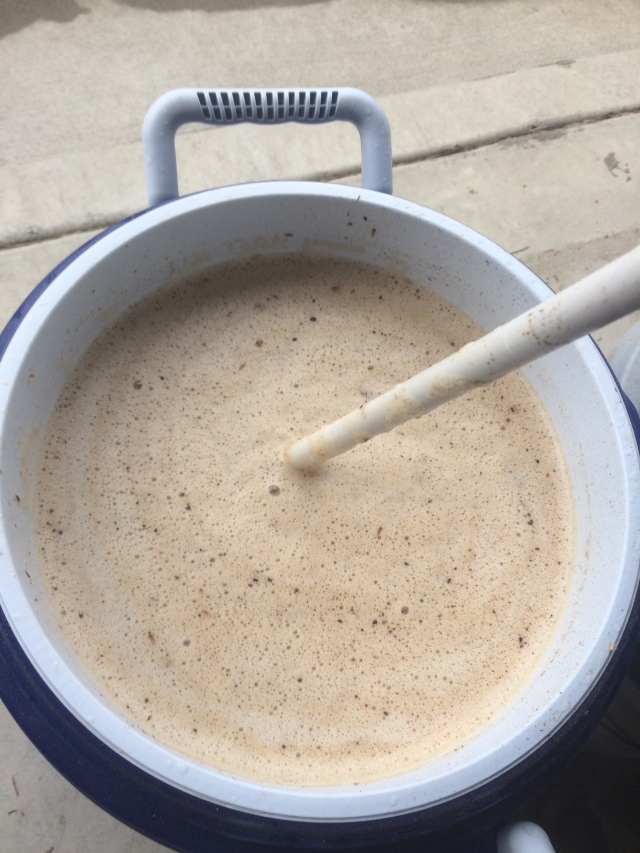
The rest of the brew day went basically as planned, boiling the wort for an hour and adding hops at the appropriate times.
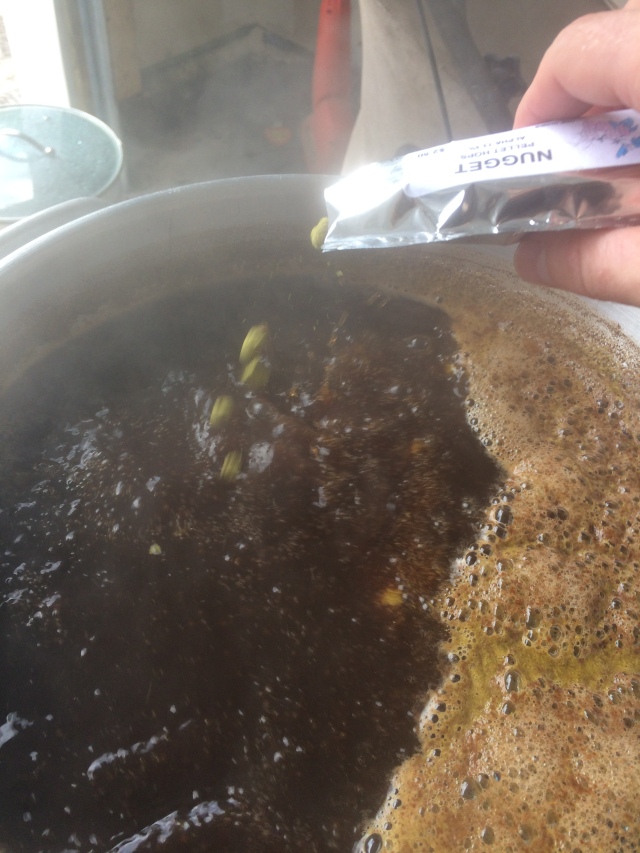
Even with my immersion chiller, I had trouble getting my wort chilled to near my target fermentation temperature. It’s been hot here for a couple months already, so my groundwater just wasn’t doing the trick at any reasonable rate. Once I felt comfortable that the wort was cool enough that thermal shock wouldn’t shatter my glass carboy, I transferred the wort and put my carboy in my fermentation chamber to chill.
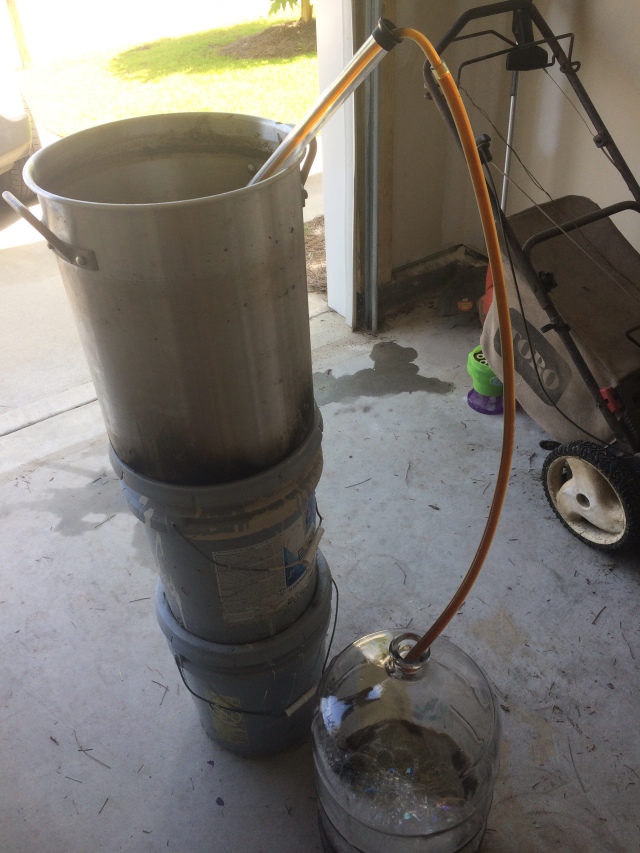
When I returned a couple hours later to check on the progress of the temperature, I found that not much had changed. The thermal mass of the wort in the fridge and the heat of the garage outside the fridge were enough that my fermentation chamber was struggling to drop the wort even a few degrees. As I was planning on pitching my yeast starter at high krausen, I didn’t want to wait until the next day to pitch my yeast. I pulled out my trusty plastic storage bin that, until recently, I had used for fermentation temperature control (via water/ice baths). I filled it with water and ice, put my carboy in, and swirled my carboy to help facilitate the heat exchange. It wasn’t long before the temperature had dropped significantly enough and I was able to pitch my yeast.
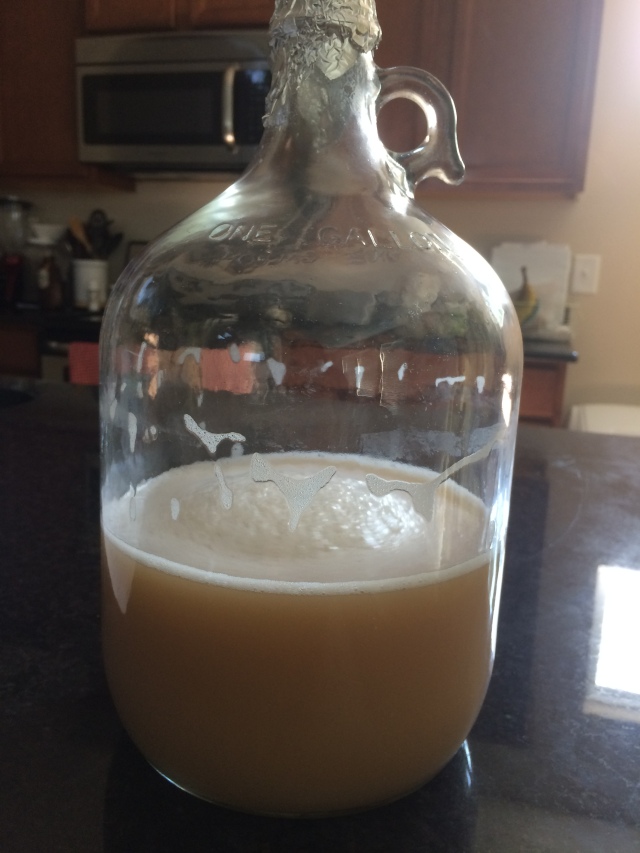
Recipe
When I tasted Iteration 6, I was surprised by its lack of aroma, especially compared to previous versions. Fighting hard to find what scents were there, I did note roasted character, toast, and dark fruit. The flavor was definitely more present than the aroma, but at first surprised me with how subdued it was compared to other versions. What I at first thought was lack of body and subdued flavor was actually (I realized after several more sips) a smoother character to the flavors. In fact, most everything from the prior iterations was there—the roasted character, some dark fruit, and a hint of chocolate once it warmed up. Those flavors were just not as hard-hitting as before.
After tasting this beer, I thought I might want to bring some of those bolder flavors back. The beer definitely needed more aroma. Before knowing what the previous brewer had changed, I was already leaning towards adding more hops, changing the hops, or changing the yeast (if the previous brewer had changed the yeast and that was the cause for the missing aroma/flavor.
As I kept drinking, though, the realizations I mentioned above began coming through, and I began to consider hops as my main focus this time in order to compliment the slight fruit character and as a counterpoint to the slight roast. Citrusy hops would have been at odds with the strong roast character from the previous versions (initially why I went with more English hops in Iteration 1), but the smoother roast character in Iteration 6 changed that for me.
When I looked at the recipe for Iteration 6, I saw that the previous brewer had, in fact, changed the yeast. Once I decided that I did enjoy the smoother roast flavors it yielded, I decided to keep that and change the hops. I considered simply adding hops for more aroma and flavor instead of changing them, but if I were going to go with a more citrus-forward hop, I didn’t think that the Willamette would pair well with that. Because of that, I ended up dropping Willamette from the recipe and added Centennial in its place to get some more citrus and floral flavor. I decided not to change the Nugget not only because it was the bittering hop and I wanted to focus more on flavor, but also because I tend to get a fruity flavor from Nugget, despite how it’s classically described, and I wanted to keep that around.
Those decisions resulted in the following recipe:
- Mashed at 155⁰ F
- 69.2%. 2-Row
- 10.8% Victory
- 7.8% Roasted Barley
- 7.8% Flaked Barley
- 4.4% Chocolate
- Boiled for 1 hr.
- 1 oz. Nugget (60 min) at 13.3% AA (44.3 IBUs)
- 1 oz. Centennial (5 min) at 9.3% AA (6.2 IBUs)
- Pitched WLP004 Irish Ale Yeast
- OG: 1.064
- FG: 1.021
- ABV: 5.6%
Tasting
This beer poured with a solid amount of tan head that stuck around for quite a while. The color was definitively black.
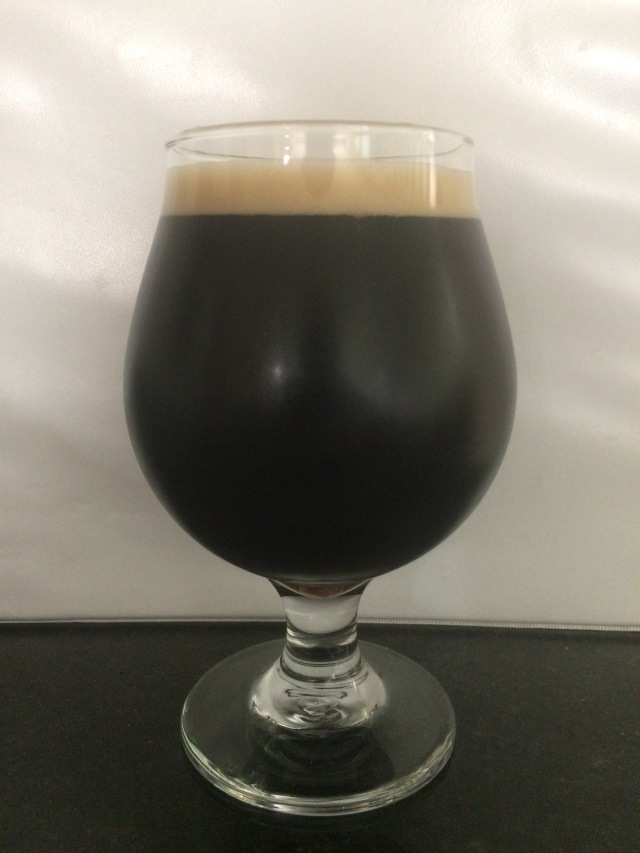
The beer had an aroma of chocolate (somewhere between milk than dark), roasted notes, a hint of coffee, and perhaps a hint of floral notes in the aroma. Either the hops are starting to come through in this beer, or I was searching hard for elements I knew might be there due to my knowledge of the ingredients—admittedly, either was possible.
The mouthfeel was thick and viscous, but not in an overwhelming way. The flavor was one of dark chocolate, toast, and a hint of coffee. Unlike my uncertainty about the floral notes truly coming through in the aroma, floral and citrus notes from the hops definitely came through in the finish of this beer.
What I Would Change
Overall, this beer is taking shape well. The change in yeast made in Iteration 6 had a huge impact on how the flavors of this beer are expressed. Truly, it almost seems as if everything is a little more muted in both the flavor and aroma, but it’s somehow working well to keep the roasted flavors in the malt smooth and out of the realm of harsh or burnt flavors.
At this point, I think the malt bill is pretty solid—though there are flavors that were present before that are no longer present with the change in yeast, namely the toastiness that the Victory was lending is less present than before, and I might want to see that level of toastiness return. That said, I’m not entirely sure if that’s a malt change or a yeast change at this point. The change in yeast has definitely improved the beer overall, making the roasted flavors taste a little rounder, but it definitely stripped the aroma and some flavors from the beer.
What I do know is that the hop change was a definite improvement and that if I were to brew this again, the one change I know I would make would be to continue playing with the hops. I think that in addition to the Centennial addition at 5 minutes, another addition of Centennial or another American hop late in the boil or at flameout would push the hops to be more present. However, I think it would be a delicate balance and wouldn’t want to add much more than that, because I think any more would detract from the malt flavors with the current malt bill and yeast selection.
Recipe Progression
| Iteration 1 | Iteration 2 | Iteration 3 | Iteration 4 | Iteration 5 | Iteration 6 | Iteration 7 | ||
| Base Malt 2-row | 80% | 80% | 80% | 72.5% | 69.2% | 69.2% | 69.2% | |
| Specialty Malt 1 | 10% Victory | 10% Victory | 5% Victory | 10.8% | 10.8% | 10.8% | 10.8% | |
| Specialty Malt 2 | 5% Roasted Barley | 5% Roasted Barley | 10% Roasted Barley | 4.4% Roasted Barley | 7.8% Roasted Barley | 7.8% Roasted Barley | 7.8% Roasted Barley | |
| Specialty Malt 3 | 5% Carafa III | 5% Chocolate Malt | 5 % Chocolate Malt | 4.4% Chocolate Malt | 4.4% Chocolate Malt | 4.4% Chocolate Malt | 4.4% Chocolate Malt | |
| Specialty Malt 4 | None | None | None | 7.8% Flaked Barley | 7.8% Flaked Barley | 7.8% Flaked Barley | 7.8% Flaked Barley | |
| 60 min. hop | Nugget: 47.7 IBUs | Nugget: 42.5 IBUs | Nugget: 47.7 IBUs | Nugget: 41.2 IBUs | Nugget: 41.5 IBUs | Nugget: 45 IBUs | Nugget: 44.3 IBUs | |
| 5 min. hop | Willamette: 3.6 IBUs | Willamette: 3.3 IBUs | Willamette: 2.9 IBUs | Willamette: 3 IBUs | Willamette: 3 IBUs | Willamette: 3.6 IBUs | Centennial: 6.2 IBUs | |
| Yeast | US-05 | US-05 | US-05 | US-05 | US-05 | White Labs Irish Ale Yeast (WLP004) | White Labs Irish Ale Yeast (WLP004) | |
| OG | 1.054 | 1.060 | 1.045 | 1.065 | 1.064 | 1.065 | 1.064 | |
| FG | 1.010 | 1.016 | 1.005 | 10.20 | 1.020 | 1.018 | 1.021 | |
| ABV | 5.8% | 5.8% | 5.25% | 5.9% | 5.8% | 6.2% | 5.6% |

Pingback: Stout: Tasting Iterations 6 & 7 | brewublog
Pingback: Stout: Iteration 8 | brewublog
Pingback: Stout: Tasting Iterations 7 & 8 | brewublog
Pingback: Stout: Iteration 10 | brewublog